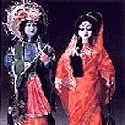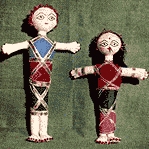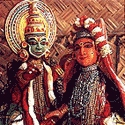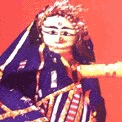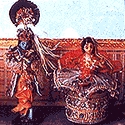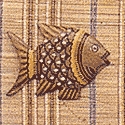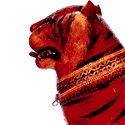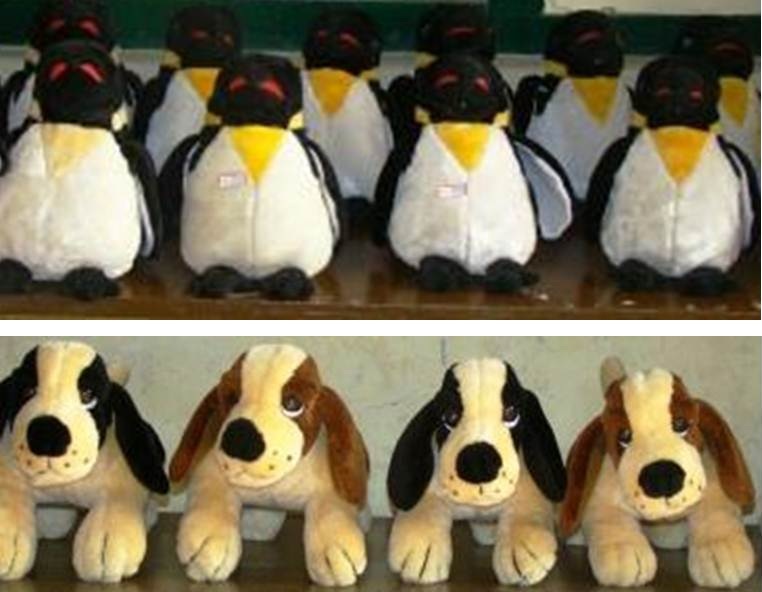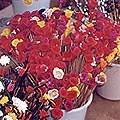The cloth dolls of Haryana range from 6 inches to 36 inches in height. They depict typical rural scenes, with models of village women with a water pot or baskets of vegetables. Group compositions --- a group of women dancing and tribal dance scenes --- are common, as are jungle scenes and epic characters like Sita, Lord Rama, and Lakshman. The clothing and jewellery of dolls is authentic to the characters.
The wooden toys of Haryana are attractive and brightly coloured. The range includes jigsaw puzzles and pull- and push-along toys which help toddlers take their first steps.
Dolls and toys in Bihar are made with different materials such as clay, cloth, and wood, with each material having its own style and designated areas where the the craft is practised. The making of clay toys and images is a seasonal craft. Votive images, dolls, and figures of animals are all made during the festive period. During Shyama Chak the entire story of the festival is narrated through clay dolls and images built around Shyama or Krishan. Clay toys in abstract folk styles --- like elephants and dancing figures --- are also crafted by the potters. The toys of Darbhanga, especially the horse and rider, are well-known. When the festival season is over, the artisans busy themselves with making domestic utility articles. Many young girls and housewives make cloth dolls as a fruitful pastime, and are particularly active during festivals and fairs. Waste pieces of cloth are used as the raw materials, an important reason for these toys being so inexpensive. Typical cloth dolls of Bihar represent couples, though Adivasi (aboriginal) dolls and their dances are also popular. The features, especially the eyes and the mouths, of the dolls are outlined with black lines. The Chota Nagpur and Ranchi areas are also known for their wooden toys. The most common figures are the mother and child and Raja-Rani that are painted on wood. The toys are notable for their artistic vigour. Many animal figures connected to rituals, acquered wooden toys modelled on folk tradition animals, birds, fish and bird figures are all carved. There is also a variety of toys made from bamboo. Ranchi has very unusual toys. They are completely abstract forms of wood with features painted on them to look like humans or other life forms. Brass and bell metal toys are now restricted to only animals.
Kerala is blessed with luxuriant wood and is an important area for toys. The main toys crafted are animals made out of rose wood. Elephant figures take precedence over all others as the demand for elephants is constant. A favourite piece is one in which two elephants are fighting each other with their trunks flung out. The toys are made by the carpenters or asaris. A large variety of kathakali figures are crafted and have a great appeal as the various kathakali characters have their doll counterparts which excite the children's curiosity. Trained artists at Calicut make a large number of figures based on the kathakali dancers and temple models out of paper pulp. They also produce lively figures of animals and birds.
Rag dolls of a special traditional variety are made in Gwalior. The faces are painted and the eyes are lively and expressive. The arms are stretched out on the two sides, the palms are coloured red, and the fingers are streaked. The costumes are made of paper which are of a traditional style. The male dolls have boat-shaped turbans on their heads while the female dolls are clothed in saris made of paper. The costumes are embellished with tin-foil, spangles, beads, and tassels. These dolls, called battubai dolls, are also dressed up in jewellery and are sold in pairs.
Lacquerware of Sawantwadi, (once a princely state) is a traditional craft, and the fruits and vegetables crafted from a light wood such as pangara and hale, are completely realistic. Sawantwadi was also famous for its ganjifa playing cards, with pictures based on mythological subjects, especially the ten avataras of Vishnu. The traditional craftsmen are known as chittorees or picture makers. The round lacquered highly pictorial ganjifa playing cards were made by the chittorees, who also painted cradles and boxes. Most of the items were painted with religious and mythological figures.
Diverse religious influences are visible in the toys of Manipur. Beautiful dolls and toys of straw and clay are made, the most popular among them being representations of Lord Krishna, and of local deities and dancing figures. These dolls are delicately modelled and decorated.
Burgarh in the Sambalpur district of Odisha is famous for its stylised wooden toys. The animal figures are richly caparisoned and, at times, even carry riders, thus times portraying strength and power. Some of these birds and animals are mythical in character. One of the most striking toys is a lion with a fat and squat body and a big stylised neck, with its face and head richly ornamented. This lion is sometimes riding on a brightly caparisoned elephant locally called Gajasinha. The toys are made of a light cream coloured and finely textured wood, the local name for which is gamhari. The wood is brightly painted. ¨ Burgarh: Wooden painted toys are made in the Burgarh area of Sambalpur in Odisha. These toys depict birds and animals, images of gods and goddesses, and human figures. All these are carved with great skill, coloured brightly, and made in the folk style. Gamhari is the local wood used for the carvings as it has a fine texture and is light-cream colour. The carvers and folk painters of Bargarh are now also making bowls, boxes, lamp stands, and other items for household use. ¨ Puri: Wooden toys here are also made of painted wood but are quite abstract in composition. The toys of Puri are usually figures of Lord Jagannath, Subhadra, and Balaram, popularly known as bara thakur. These toys have a huge head, and eyes that are round or elongated, covering half the face, and short stunted hands. They have no legs and are always found squatting on the ground. One of the popular figures is that of Ravan with 10 heads in bright colours. There are also painted horses and elephants. Saki, the local name for a maiden companion is a colourfully attired woman adorned with ornaments.
Udaipur is a big center for wooden toys. The wood used is doodhia which is soft and can be finely chiselled and shaped. The toys are lacquered by pressing the lac stick against the revolving article and oil is also applied at the same time to give a better polish. Leaves of a flowering cactus are used for polishing. The articles are in a single colour or in rings or bands of different colours. By manipulating the lac turney and using several techniques, complicated designs and colour schemes are possible in the toy-making craft. A large variety of toys are made in Udaipur, including the cart drawn by a sparrow, kitchen sets, singardan (box with articles of toilet), grinder, and cradle on a stand. The modern toys made are gas lantern, gramophones, trains, cars, jeeps, aeroplanes, counting stands, and clock towers. Animal figures include horses, camels, and elephants. The shapes and the colouring of the toys are attractive. Udaipur is also famous for imitation dry fruit. They look very real in appearance. Bassi in Chittorgarh district is another noted center for wooden toys. The entire village is engaged in wood-carving and in making wooden products. Jaipur is very well-known for cloth dolls and toys. The dolls are made of old cloth which is dyed and stuffed with waste material. They are gaily decorated with coloured paper and tinsel and they have expressive faces.
The Soft Toys & Dolls unit, a part of the Directorate of Handicrafts and Handloom (DHH), Gangtok was set up with an aim to promote local economic stability and employability and thus, targets export based opportunities for the sector.
The raw materials used in the making process are considered to be the best, leading to exceptional quality and cost competitiveness as compared to other toy clusters. The toys are handmade with the help of auxiliary mechanical equipment for stitching and joining fabric layers - synthetic fur, polyester are some of the fabrics used.
The product is first designed manually or digitally. Once the design is finalised, the making process starts with pattern making, cutting, stitching, stuffing cotton and finally finishing which includes trimmings and attaching the face features of the designed toy. The approved sample is then converted into a mould for efficient production at the mass level.
The product range includes dolls and soft toys of all kinds of animals - rabbits, cows, monkeys, ducks etc. With time, the craftspeople with DHH are also said to be working towards imbibing the local ethos of Sikkim in these handmade dolls and toys, taking inspiration from traditional Sikkimese attire.
The dwellers of this bamboo rich state have made ingenious toys using the most abundant resource of the state. Some of the toys made of bamboo are the bamboo pop gun, made by the local craftspersons in Tripura, Assam and Mizoram. The pop gun functions much like a gun in that it releases a small pellet, in this case placed inside the barrel of the gun, which is made of bamboo. A mechanism is provided to regulate the release of the pellet. This device seems to have developed from the innumerable bird and animal traps that are used locally. Other toys that can be seen are the tiny bamboo whistles made from small diameter culm lengths. The whistle gives a shrill sound, when blown. Bamboo flutes of different types are also being made --- some of these are used as toys while others are for professional use. Apart from these, Agartala has a tradition of weaving small animals from bamboo splits.
Walnut wood carving is absolutely unique to Kashmir as the walnut trees can be found in abundance around the region. The walnut wood gives a differentiable shine and texture to the beautifully carved wooden dolls. The varied levels of carving can be achieved with chisels and wooden mallet. The engraver first creates a sketch on the wood and then carves out. Shallow etchings is used for lattice work while etches can go deep down up to 2 inches for flower motifs or dragons. Chinar motif is the most common motif replicated by the carvers on the wood as chinar leaf is profusely growing in the region. Along with the villages in Srinagar disrtrict, Rajouri, Badgam, Kupwara, Jammu and Kathua district are also identified as the walnut wood carving clusters. The shrines, mausoleums in Kashmir are one of the finest examples of intricate wood carvings. The products of the walnut wood carving was earlier restricted to buildings and palaces. Recently products like Jewelry boxes, dolls, toys, frames, lamps, trays, tables, furniture and boxes are being manufactured.
Corn husk is the raw material used to make unusual miniature dolls. These miniature figures accurately portray a range of different occupations, tribes, and ethnic groups - peasants, farmers, shepards, weavers are all portrayed, accurate to every minute detail of dress, ornaments, and footwear. Packaged either individually or in pairs, these corn husk dolls are popular with tourists. They are produced in the Kathmandu Valley.
Patan, in Gujarat, is home to double ikat fabrics, also called Patola. Double ikat is a technique of resist dyeing which is practised in Patan, Gujarat. This technique involves interlacing the warp and weft with dyes to achieve the required designs. Patola sarees are woven in silk and traditional intricate motifs designs like elephant, peacock, kalasha (pot), parrot, basket, jewellery pattern, foliage, creepers, abstract geometrical patterns etc. Now, with the experimentation in design, new designs in motifs are also practised along with the traditional motifs. A peculiar characteristic of patola is that the pattern or motifs designs on the saree is the same on both the sides making it wearable from the reverse side also.
The array of dried flowers surrounding Tho Ritse from Nagaland embody a craft form whose hallmark is personal creativity and innovation - flowers, leaves, fruit, berries, grasses and reeds are converted with the help of ideas and dextrous fingers into various dried flower and leaf creations. A big, berry-shaped fruit is cut in half, the inside of both halves scooped out, the outer hollow dried and each half attached to a stick to create two, half-moon shaped floral abstractions. Thin strips of bamboo are cut in the shape of long petals, the petals are arranged by hand into a shape resembling an open flowers, the arranged petals are brought together at the base, wire is twined through them, and they are attached to a stick. Leaves of the Pipal tree (Ficus religiosa) are twisted into the shape of a rosebud and then left to dry till only the delicate vein filigree remains. There are as many creations and innovative variations as there are craftspersons. This is essentially a craft which relies on imaginative use of the grasses, leaves and fruits found in this densely forested state and on the dexterity of the craftspersons fingers in moulding them into interesting creations; in this sense the term 'dried flowers' is an extremely limited definition of this craft which involves much more than merely drying flowers. There are few technical rules pertaining to the craft. One of the few rules that do apply is the commonsense one that the leaves and reeds have to be twisted into the desired shape before they are dried; after they are dry they will be too brittle to be moulded. Colour is also used to make these dried flowers more attractive though now synthetic rather than natural dyes are used. Both men and women practise this craft; however, it is not even remotely adequate as a livelihood. Neither is the output enough to sustain a livelihood, nor is there any sort of organisation about production, sale and export. In fact, is it perhaps just the personal creativity of individual craftspersons that keeps this 'craft form' alive.
Drift root or the root of the 'Sea Mova' tree is available along the seashore. The best pieces of wood are chosen to carve out shapes and figures. The shapes crafted include figures of gods, goddesses, humans, birds and animals. Shapes are made from the wood by cutting, filing and sand-piping. Filling is done with glass pieces. Finishing is done with sand paper and wood varnish. Stands for the sculptures are carved from the same piece of wood. The entire sculpture is of one piece, without any joints. Supports are added to the rear to make the sculpture more stable.
Drift root or the root of the 'Sea Mova' tree is available along the seashore. The best pieces of wood are chosen to carve out shapes and figures. The shapes crafted include figures of gods, goddesses, humans, birds and animals. Shapes are made from the wood by cutting, filing and sand-piping. Filling is done with glass pieces. Finishing is done with sand paper and wood varnish. Stands for the sculptures are carved from the same piece of wood. The entire sculpture is of one piece, without any joints. Supports are added to the rear to make the sculpture more stable.
Drift root or the root of the 'Sea Mova' tree is available along the seashore. The best pieces of wood are chosen to carve out shapes and figures. The shapes crafted include figures of gods, goddesses, humans, birds and animals. Shapes are made from the wood by cutting, filing and sand-piping. Filling is done with glass pieces. Finishing is done with sand paper and wood varnish. Stands for the sculptures are carved from the same piece of wood. The entire sculpture is of one piece, without any joints. Supports are added to the rear to make the sculpture more stable.
Drift root or the root of the 'Sea Mova' tree is available along the seashore. The best pieces of wood are chosen to carve out shapes and figures. The shapes crafted include figures of gods, goddesses, humans, birds and animals. Shapes are made from the wood by cutting, filing and sand-piping. Filling is done with glass pieces. Finishing is done with sand paper and wood varnish. Stands for the sculptures are carved from the same piece of wood. The entire sculpture is of one piece, without any joints. Supports are added to the rear to make the sculpture more stable.
